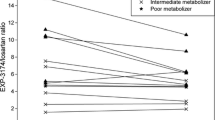Abstract
Objectives
The aims were to investigate: (1) The renal elimination of quinine and its metabolites 3-hydoxyquinine, 2′-quininone, (10R) and (10S)-11-dihydroxydihydroquinine and (2) the relative importance of CYP3A4, CYP1A2 and CYP2C19 for the formation of 2′-quininone, (10R) and (10S)-11-dihydroxydihydroquinine in vivo.
Methods
In a randomised three-way crossover study, nine healthy Swedish subjects received a single oral dose of quinine hydrochloride (500 mg), on three different occasions: (A) alone, (B) concomitantly with ketoconazole (100 mg twice daily for 3 days) and (C) concomitantly with fluvoxamine (25 mg twice daily for 2 days). Blood and urine samples were collected before quinine intake and up to 96 h thereafter. All samples were analysed by means of high-performance liquid chromatography.
Results
Co-administration with ketoconazole significantly increased the area under the plasma concentration versus time curve (AUC) of 2′-quininone, (10S)-11-dihydroxydihydroquinine, and (10R)-11-dihydroxydihydroquinine, the geometric mean ratios (90% CI) of the AUC were 1.9 (1.8, 2.0), 1.3 (1.1, 1.7) and 1.6 (1.4, 1.8), respectively. Co-administration with fluvoxamine had no significant effect on the mean AUC of any of the metabolites. A mean of 56% of the administered oral quinine dose was recovered in urine after hydrolysis with β-glucuronidase relative to the 40% recovered before hydrolysis.
Conclusion
Quinine is eliminated in urine mainly as unchanged drug and as 3-hydroxyquinine. The major metabolite of quinine is 3-hydroxyquinine formed by CYP3A4. There is no evidence for the involvement of CYP3A4, 1A2 or 2C19 in the formation of 2′-quininone, (10S)-11-dihydroxydihydroquinine and (10R)-11-dihydroxydihydroquinine in vivo. Glucuronidation is an important pathway for the renal elimination of quinine, mainly as direct conjugation of the drug.


Similar content being viewed by others
References
World Health Organization (2000) Management of severe malaria: a practical handbook. WHO, Geneva
Liddle C, Graham GG, Christopher RK, Bhuwapathanapun S, Duffield AM (1981) Identification of new urinary metabolites in man of quinine using methane chemical ionization gas chromatography-mass spectrometry. Xenobiotica 11:81–87
Zhao XJ, Yokoyama H, Chiba K, Wanwimolruk S, Ishizaki T (1996) Identification of human cytochrome P450 isoforms involved in the 3-hydroxylation of quinine by human liver microsomes and nine recombinant human cytochromes P450. J Pharmacol Exp Ther 279:1327–1334
Zhang H, Coville PF, Walker RJ, Miners JO, Birkett DJ, Wanwimolruk S (1997) Evidence for involvement of human CYP3A in the 3-hydroxylation of quinine. Br J Clin Pharmacol 43:245–252
Zhao XJ, Ishizaki T (1997) The in vitro hepatic metabolism of quinine in mice, rats and dogs: comparison with human liver microsomes. J Pharmacol Exp Ther 283:1168–1176
Mirghani RA, Yasar U, Zheng T, Cook JM, Gustafsson LL, Tybring G, Ericsson O (2002) Enzyme kinetics for the formation of 3-hydroxyquinine and three new metabolites of quinine in vitro; 3-hydroxylation by CYP3A4 is indeed the major metabolic pathway. Drug Metab Dispos 30:1368–1371
Morel F, Beaune PH, Ratanasavanh D, Flinois JP, Yang CS, Guengerich FP, Guillouzo A (1990) Expression of cytochrome P-450 enzymes in cultured human hepatocytes. Eur J Biochem 191:437–444
Oesch F, Arand M, Benedetti MS, Castelli MG, Dostert P (1996) Inducing properties of rifampicin and rifabutin for selected enzyme activities of the cytochrome P-450 and UDP-glucuronosyltransferase superfamilies in female rat liver. J Antimicrob Chemother 37:1111–1119
Wanwimolruk S, Kang W, Coville PF, Viriyayudhakorn S, Thitiarchakul S (1995) Marked enhancement by rifampicin and lack of effect of isoniazid on the elimination of quinine in man. Br J Clin Pharmacol 40:87–91
Sai Y, Dai R, Yang TJ, Krausz KW, Gonzalez FJ, Gelboin HV, Shou M (2000) Assessment of specificity of eight chemical inhibitors using cDNA-expressed cytochromes P450. Xenobiotica 30:327–343
Mirghani RA, Hellgren U, Westerberg PA, Ericsson O, Bertilsson L, Gustafsson LL (1999) The roles of cytochrome P450 3A4 and 1A2 in the 3-hydroxylation of quinine in vivo. Clin Pharmacol Ther 66:454–460
Brosen K, Skjelbo E, Rasmussen BB, Poulsen HE, Loft S (1993) Fluvoxamine is a potent inhibitor of cytochrome P4501A2. Biochem Pharmacol 45:1211–1214
Jeppesen U, Rasmussen BB, Brosen K (1997) Fluvoxamine inhibits the CYP2C19-catalyzed bioactivation of chloroguanide. Clin Pharmacol Ther 62:279–286
Christensen M, Tybring G, Mihara K, Yasui-Furokori N, Carrillo JA, Ramos SI, Andersson K, Dahl ML, Bertilsson L (2002) Low daily 10-mg and 20-mg doses of fluvoxamine inhibit the metabolism of both caffeine (cytochrome P4501A2) and omeprazole (cytochrome P4502C19). Clin Pharmacol Ther 71:141–152
Paintaud G, Alvan G, Ericsson O (1993) The reproducibility of quinine bioavailability. Br J Clin Pharmacol 35:305–307
Mirghani RA, Ericsson O, Cook J, Yu P, Gustafsson LL (2001) Simultaneous determination of quinine and four metabolites in plasma and urine by high-performance liquid chromatography. J Chromatogr B Biomed Sci Appl 754:57–64
Ono S, Hatanaka T, Hotta H, Satoh T, Gonzalez FJ, Tsutsui M (1996) Specificity of substrate and inhibitor probes for cytochrome P450s: evaluation of in vitro metabolism using cDNA-expressed human P450s and human liver microsomes. Xenobiotica 26:681–693
Newton DJ, Wang RW, Lu AY (1995) Cytochrome P450 inhibitors. Evaluation of specificities in the in vitro metabolism of therapeutic agents by human liver microsomes. Drug Metab Dispos 23:154–158
Gibbs MA, Thummel KE, Shen DD, Kunze KL (1999) Inhibition of cytochrome P-450 3A (CYP3A) in human intestinal and liver microsomes: comparison of Ki values and impact of CYP3A5 expression. Drug Metab Dispos 27:180–187
Jeppesen U, Gram LF, Vistisen K, Loft S, Poulsen HE, Brosen K (1996) Dose-dependent inhibition of CYP1A2, CYP2C19 and CYP2D6 by citalopram, fluoxetine, fluvoxamine and paroxetine. Eur J Clin Pharmacol 51:73–78
Acknowledgements
This work was supported by the Swedish Agency for Research Collaboration with Developing Countries grants no. Bil Tz 16/98 75007059, SWE 1997–221, 1998–394, 1999–260, 2000–175, the Swedish Medical Research Council grant no. 3902, the National Institutes of Health, USA (1R01 GM60548–02) and funds from Karolinska Institutet. We extend our thanks to the research nurses Katarina Andersson and Eva Götharson for their professional help in performing the study.
Author information
Authors and Affiliations
Corresponding author
Rights and permissions
About this article
Cite this article
Mirghani, R.A., Hellgren, U., Bertilsson, L. et al. Metabolism and elimination of quinine in healthy volunteers. Eur J Clin Pharmacol 59, 423–427 (2003). https://doi.org/10.1007/s00228-003-0637-8
Received:
Accepted:
Published:
Issue Date:
DOI: https://doi.org/10.1007/s00228-003-0637-8




